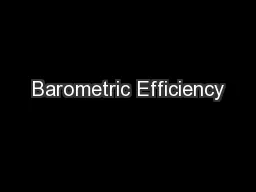

The observed influence of barometric pressure BP on water levels WL Defined using BE WL BP This method looks at longterm changes of BP on WL Another method accounts for shortterm changes ID: 171327
Download Presentation The PPT/PDF document "Barometric Efficiency" is the property of its rightful owner. Permission is granted to download and print the materials on this web site for personal, non-commercial use only, and to display it on your personal computer provided you do not modify the materials and that you retain all copyright notices contained in the materials. By downloading content from our website, you accept the terms of this agreement.
Slide1
Barometric Efficiency
The observed influence of barometric pressure (BP) on water levels (WL)
Defined using:
BE = - WL / BP
This method looks at long-term changes of BP on WL
Another method accounts for short-term changes
BE = - ∆WL/ ∆BP
These assume that the response is instantaneous
Normally applied to confined aquifers
Because surface loading causes aquifer compression
Part of the load borne by water, rest by mineral skeleton
Also see a response due to trains, tides, precipitationSlide2
Tidal Efficiency, TE
TE = ∆TH / ∆BP
= ∆ (WL + BP) / ∆BP
= - BE + 1
so that
TE + BE = 1
Inelastic
BE = 1 TE = 0
Elastic
BE = 0 TE = 1 Slide3
Specific storage (
S
s
)Aquifer porosity (n)Aquifer bulk modulus of elasticity (Es)Specific weight of water (w) = 9.8 kPa/mBulk modulus of water (Ew) = 2.2 GPa Bulk modulus is reciprocal of the compressibility Slide4
Delayed Response
For situations where the response is not instantaneous, we must use convolution:
∆TH(t) = ∑
i u(i) ∆BP(t-i) = u(0) ∆BP(t) + u(1) ∆BP(t-1) + u(2) ∆BP(t-2) + where u(i) is the unit response functionDelayed responses occur for various reasonswater table (unconfined)wellbore storagedual porositySlide5
Effects of a barometric pressure step increase in an unconfined aquifer
Diagram of locations of measurement points 1 and 2 within the well and aquifer, respectively
pressure head
total head
water levels